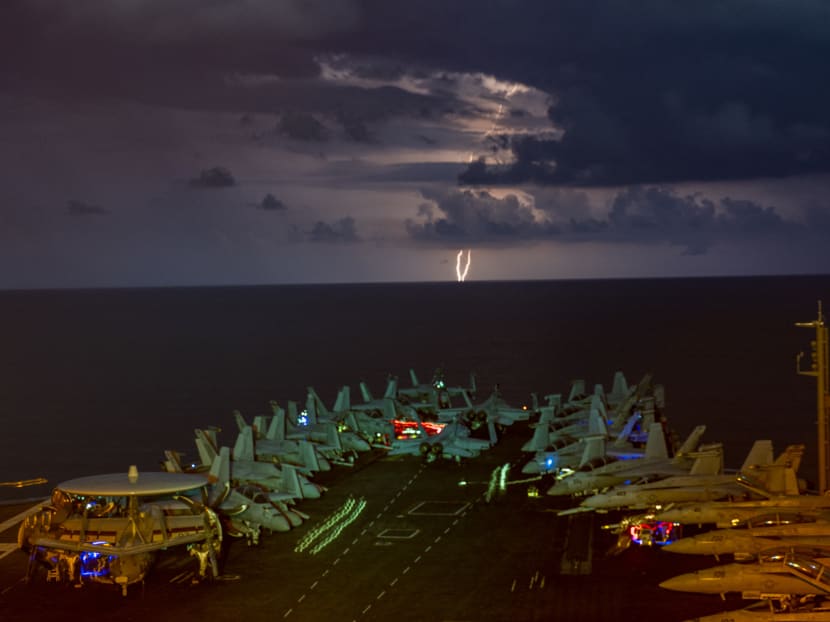The risk of China-US military conflict is worryingly high
The relationship between China and the United States is in freefall. That is dangerous. US defence secretary Mark Esper has said he wants to visit China this year, which shows the Pentagon is worried. That Wei Fenghe, China’s defence minister, spoke at length with Mr Esper in August shows that Beijing is worried too.

Hand out photo dated July 4 2020 of lightning flashes over US aircraft carrier USS Nimitz as it transits the South China Sea along with another aircraft carrier USS Ronald Reagan. It marked the first time two US aircraft carriers have operated together there since 2014.
The relationship between China and the United States is in freefall. That is dangerous. US defence secretary Mark Esper has said he wants to visit China this year, which shows the Pentagon is worried.
That Wei Fenghe, China’s defence minister, spoke at length with Mr Esper in August shows that Beijing is worried too.
Both men have agreed to keep communications open and to work to reduce risks as they arise. The crucial question is: how?
In July, US secretary of state Mike Pompeo inverted a famous line of Ronald Reagan’s about the Soviet Union and applied it to China: “Trust but verify” became “distrust but verify”.
Washington suspects that an increasingly coercive China wants to drive the US out of the Indo-Pacific. Beijing meanwhile believes that the US, worried about its global primacy, has fully abandoned its supposed neutrality on the South China Sea.
Haunted by economic recession and the pandemic, and desperate for re-election, President Donald Trump has also made confronting China his last-straw strategy to beat his opponent, Joe Biden.
The risk of a mistake is therefore high. It is one thing for the two countries to point their fingers at each other.
It is quite another if naval vessels collide in the South China Sea, triggering a direct conflict.
In 2019, the US navy conducted a record number of freedom of navigation operations there. Mr Esper has vowed to keep up the pace this year.
So far, whenever a US ship has come close to China-controlled islands, Chinese naval ships have monitored it and warned it to leave.
This pattern might continue without accident, allowing both sides to “save face”.
The US can claim its freedom of navigation operations have challenged China’s “militarisation” of the area. China can also say it has driven away intruders from its waters.
But that ignores the chance of mishap. The air collision in 2001 between a Chinese jet fighter and a US reconnaissance plane caused the death of one Chinese pilot.
In 2018, the USS Decatur and Chinese destroyer Lanzhou escaped collision by just 41 metres. Both sides have pledged to keep at a safe distance during these encounters. Yet what is a safe distance exactly?
For the US, the Chinese islands are artificial land reclamations, so a US warship can legally sail as close as 500 metres.
But for Beijing, these are natural Chinese territories that China has chosen to enlarge, and the fact they had names before land reclamation are proof they are not artificial.
Under Chinese law, a foreign military vessel’s entry into territorial seas needs government approval.
China and the US could then even fight each other under the same international laws.
Washington cites Article 58 of the UN convention on the law of the sea to justify its right of freedom of navigation and overflight.
But Beijing can quote the same article, which says: “States shall have due regard to the rights and duties of the coastal State.”
How to de-risk the chance of a conflict that neither side wants but which they could nevertheless sleepwalk into?
During the cold war, the US and USSR competed via proxy wars, avoiding direct conflict.
Should a similar competition arise today, America’s Asian allies most probably wouldn’t follow the US into war with a neighbour that has nuclear weapons and is their biggest trading partner.
Meanwhile, if US ships and aircraft continue to maintain high-intensity surveillance of the South China Sea, there is always the potential for a confrontation.
Beijing has no plan to take Washington. From Beijing’s point of view, it is the US that comes provocatively close to China.
Eventually, it may be that the sheer size of China’s military prompts a US rethink. The Chinese army enjoys the convenience of geography, to say the least.
Its navy also outnumbers the US navy in terms of warships and submarines, although the US fleet is more heavily armed.
Admiral Philip S Davidson, commander of the US’s Indo-Pacific Command, has acknowledged that there is “no guarantee” the US would win a future conflict against China.
China’s foreign minister Wang Yi has said Beijing will remain “cool headed” whenever there are “impulsive moves” from the US.
But in many ways, China hawks such as Mr Pompeo have made it hard for subsequent administrations to de-escalate US competition with China.
It is therefore reasonable to ask: What difference will Mr Esper’s trip to China this year make?
But the visit itself is a valuable step forward in communication and risk reduction. Talking past each other is better than not talking at all. FINANCIAL TIMES
ABOUT THE AUTHOR:
Zhou Bo is a senior fellow at the Center for International Security and Strategy at Tsinghua University.






